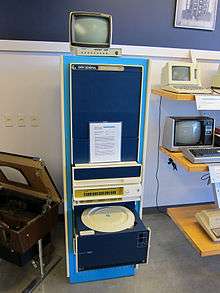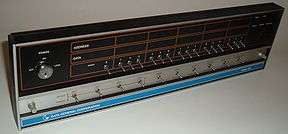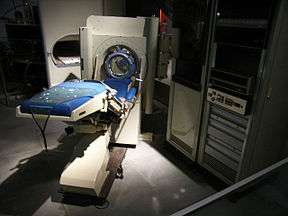Data General Nova



The Data General Nova is a series of 16-bit minicomputers released by the American company Data General. The first model of Nova, called simply the "Nova", was released in 1969.[1] The Nova was packaged into a single rack mount case and had enough power to do most simple computing tasks. The Nova became popular in science laboratories around the world. It was succeeded by the Data General Eclipse, which was similar in most ways but added virtual memory support and other features required by modern operating systems.
History
Edson de Castro was the Product Manager of the pioneering PDP-8 at Digital Equipment Corporation (DEC), a 12-bit computer generally considered by most to be the first true minicomputer.[2] De Castro was convinced that it was possible to improve upon the PDP-8 by building a 16-bit minicomputer with better performance and lower cost than the PDP-8.[3] de Castro left DEC[3] along with another hardware engineer, Richard Sogge, and a software engineer, Henry Burkhardt III, to found Data General (DG) in 1968.[4] The fourth founder, Herbert Richman, had been a salesman for Fairchild Semiconductor and knew the others through his contacts with Digital Equipment.[4]
In keeping with the PDP-8, the Nova was based on 15 by 15 inches (38 cm × 38 cm) printed circuit boards.[5][6] The boards were designed so they could be connected together using a printed circuit backplane, with minimal manual wiring, allowing all the boards to be built in an automated fashion. This greatly reduced costs over the traditional wire-wrapping technique.[7] The larger-board construction also made the Nova more reliable, which made it especially attractive for industrial or lab settings. Fairchild Semiconductor provided the new medium-scale integration (MSI) chips used throughout the system.[8][9] The Nova was one of the first 16-bit minicomputers and was a leader in moving to word lengths that were multiples of the 8-bit byte in that market.
DG released the Nova in 1969 at a base price of US$3,995,[10] advertising it as "the best small computer in the world."[11] The basic model was not very useful out of the box, and adding RAM in the form of core memory typically brought the price up to $7,995. Starting in 1969, Data General shipped a total of 50,000 Novas at $8000 each.[12] The Nova’s biggest competition was from the new DEC PDP-11 computer series, and to a lesser extent the older DEC PDP-8 systems.[13] The Nova became popular in scientific and laboratory uses.[14][15][16]
Performance
The Nova 1200 executed core memory access instructions (LDA and STA) in 2.55 microseconds (μs). Use of read-only memory saved 0.4 μs. Accumulator instructions (ADD, SUB, COM, NEG, etc.) took 1.55 μs, MUL 2.55 μs, DIV 3.75 μs, ISZ 3.15-4.5 μs.[17] On the later Eclipse MV/6000, LDA and STA took 0.44 μs, ADD, etc. took 0.33 μs, MUL 2.2 μs, DIV 3.19 μs, ISZ 1.32 μs, FAD 5.17 μs, FMMD 11.66 μs.[18]
References
- ↑ "Computer History Museum - Data General Corporation (DG) - The Best Small Computer in the World".
- ↑ Hey, Tony; Hey, Anthony; Pápay, Gyuri (2014). The Computing Universe: A Journey through a Revolution. p. 165.
- 1 2 Jeffrey S. Young (29 September 1998). Forbes Greatest Technology Stories: Inspiring Tales of the Entrepreneurs and Inventors Who Revolutionized Modern Business. John Wiley & Sons. pp. 104–. ISBN 978-0-471-24374-8.
- 1 2 Jon Peddie (13 June 2013). The History of Visual Magic in Computers: How Beautiful Images are Made in CAD, 3D, VR and AR. Springer Science & Business Media. pp. 154–. ISBN 978-1-4471-4932-3.
- ↑ Paul E. Ceruzzi (2003). A History of Modern Computing. MIT Press. pp. 195–. ISBN 978-0-262-53203-7.
- ↑ Modern Data Systems. Delta Publications. 1968.
- ↑ Electronic Products Magazine. United Technical Publications. 1972.
- ↑ Katherine Maxfield (8 April 2014). Starting Up Silicon Valley: How ROLM Became a Cultural Icon and Fortune 500 Company. Emerald Book Company. pp. 26–. ISBN 978-1-937110-63-5.
- ↑ The Electronic Engineer: EE. Chilton Company. 1969.
- ↑ Ziff Davis, Inc. (July 1986). PC Mag. Ziff Davis, Inc. pp. 53–. ISSN 0888-8507.
- ↑ Tracy Kidder (23 August 2011). The Soul of A New Machine. Little, Brown. pp. 17–. ISBN 978-0-316-20455-2.
- ↑ Dan Ryan (14 April 2011). History of Computer Graphics: DLR Associates Series. Author House. pp. 225–. ISBN 978-1-4567-5115-9.
- ↑ Edwin D. Reilly (3 September 2004). Concise Encyclopedia of Computer Science. John Wiley & Sons. pp. 266–. ISBN 978-0-470-09095-4.
- ↑ Paul Coates (6 October 2010). Programming.Architecture. Routledge. pp. 180–. ISBN 978-1-136-89905-8.
- ↑ Computerized Laboratory Systems: A Symposium Presented at the Pittsburgh Conference, American Society for Testing and Materials, Cleveland, Ohio, 4-5 March 1974. ASTM International. 1975. pp. 152–. ISBN 978-0-8031-0268-2.
- ↑ J. Anderson (6 December 2012). Medical Informatics Europe 78: First Congress of the European Federation for Medical Informatics Proceedings, Cambridge, England September 4 – 8, 1978. Springer Science & Business Media. pp. 566–. ISBN 978-3-642-93095-9.
- ↑ Technical Manual Nova 1200, Data General 015-000002, 1971, p.1-4
- ↑ Eclipse MV/6000 Principles of Operation, Data General 014-000648, 1980, App. F
External links
| Wikimedia Commons has media related to Data General. |
- Bob Supnik’s SimH project – Includes a basic Nova emulator in a user-modifiable package
- The portable C compiler includes a NOVA target.
- A portable PDP-8 and DG Nova cross-assembler
- Carl Friend’s Minicomputer Museum – Describes the Nova instruction set in detail